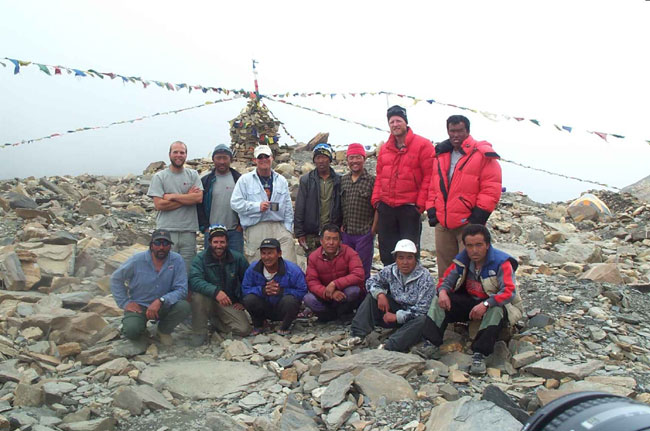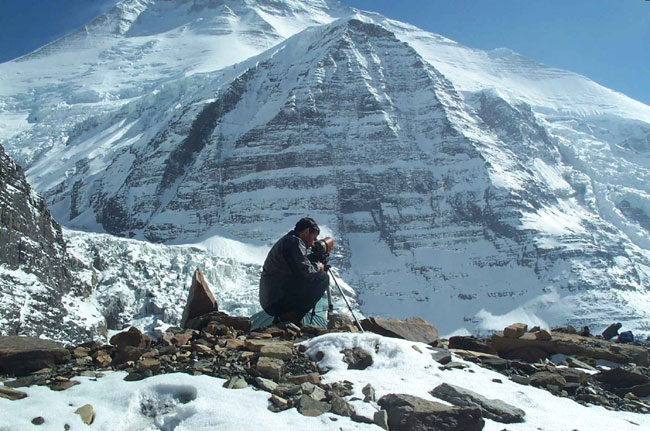In the Spring of 2002 there was well over 1000 people making up dozens of expeditions on Mount Everest, the highest mountain in the World. Meanwhile, a little further to the west on the 7th highest mountain in the world, Dhaulagiri…there was only one expedition. And I was there!
A Stroll Down Memory Lane on my First 8000 Meter Peak
Green foam was frothing towards the top of the pot. I caught Lakpa scooping it up with a spoon and slapping it to the ground. He thought I didn’t see, but I did. What I didn’t see was all the creepy and crawly things swimming around in my soon to be filled water bottle.
Any sane person would have pushed the water to the side and said “no thank you”. Or maybe a really polite sane person would have nicely asked, “is there any different water available”? But no, not me. We were in the middle of nowhere in western Nepal.
All the Sherpas were in the kitchen tent and I decided to join them. I felt good and it was nice to hang with my new friends. We spent the day doing a carry of gear to 16,000 feet. So as I sat there in the kitchen tent I watched the guys sipping tea and drinking water. So I thought, “hey, it looked gross but I’m sure it’s fine, after all the water was boiling”.
Exactly one hour and twenty-two minutes later my intestines were boiling as I lay in my tent. The pressure in my lower gut was building and I knew what would happen if I even winced let alone gave a little “belly push” to relieve my gas. My mind said no but my body said yes.
Right then and there as the sun was setting in the Himalayas, I had a little accident. “Oops I crapped my pants” is all I could say. But no one was there to hear me. It was the beginning of my first 8000 meter expedition. And a week into it I had been reduced to a baby. I didn’t bother to cry, I wanted to but it wouldn’t matter, no one was going to come running to change my diapers.
Remote and desolate are two good words to use when describing Dhaulagiri. Most folks really only know the name of the grandest mountain of them all. Ask anyone to name one of the highest mountains in the World and you’ll most likely hear Everest ten times out of ten.
At 26,794 feet, Dhaulagiri claims the prize as the seventh highest mountain in the world. Its location is far west Nepal and it’s a little “outta the way”. It’s not the highest in the world, that title belongs to big brother to the East. And that is why not too many folks know about the mountain, let alone have seen it.
Support is needed in a large expedition in the Himalaya. There are a lot of roles that are needed in order to ultimately accomplish the goal. Seeing that this was my first Himalayan expedition my role was “load carrier”. I personally find the word “grunt” to describe the position more effectively.
The Leader of the expedition was Robert Link. So basically what ever Robert wanted or needed to get done, we would do it. Whatever the job. I was not alone in my role as Grunt. Another guide, Mike Styllas joined the expedition. Since Mike was from Greece, he was appropriately and happily known as “The Greek”. The Greek and I were ecstatic at the opportunity to participate on such a novel expedition. And it did not take Robert long to put The Greek and I to work. We parted ways early on and began helping our Sherpa and porter crew move gear towards Base Camp.
Pony Express or in Nepal’s case “Yak Express” does not exist way out in “no man’s land” of Dhaulagiri. Again, this ain’t like Everest where you throw your gear on a giant yak train while you walk from tea house to tea house eating biscuits and drinking tea.
In addition, in the Everest region the Sherpa people have grown into the business of carrying loads, better known as portering for trekkers and climbers. Out in the west of Nepal in the Dhaulagiri region, the people don’t do that kind of work. They mainly farm potatoes and rice. They raise chickens and small ponies.
Our team was hoping to have the assistance of the ponies to carry some of our gear. However, heavy snow blanketed the region making the way too dangerous for the ponies. And there was no chance of hiring anyone in the area to help us move all our gear, food and equipment to live for two months.
Adversity is the name of the game in high altitude mountaineering. As the Leader of the expedition, Robert needed to do some problem solving. And his skills were needed at all time. A few porters were flown in from the Everest region. With our team of High Altitude Climbing Sherpas, the porters and The Greek and I started hauling heavy loads for the team.
Competent and strong is what every professional guide hopes for when they begin climbing with a team. Our 2002 Dhaulagiri Team were no strangers to big mountains. It was in a sense, a private expedition. Headed up by Andy, we had a total of five climbers. Robert Link was the Leader, long time guide Mike Lindaas was Co-Leader, then you had The Greek and me. And in addition, we had Tommy Heinrich who was filming and photographing the expedition. Tommy was the first Argentinian to summit Everest.
Of course the All-Stars were our Sherpa staff. We had five of the strongest brothers on the block. Yes! All established High Altitude Climbing Sherpas are strong. But there is a difference between strong and Strong. The Nomad Expedition crew had the solid reputation around the Everest region of being the strongest and most competent in the business.
To call our climbers clients would be an utmost insult. Andy and his two brother in laws knew more than half the mountain guides I know. Heck, they know things that I don’t know. Climbing an 8000 meter peak is serious business. To have the caliber of climbers on our team that we had made things a little less stressful.
What was just as important if not more, was the fact that Andy and his bros, our entire team for that matter were a lot of fun to live with alone on a desolate 8000 meter mountain.
Nostalgic now but a little spooky then, we had Dhaulagiri all to ourselves. In the spring of 2002, we were the only expedition on the mountain. Never in my life has that happened before or since. It gave us the feeling like we were the first ones ever to the mountain.
Like the Swiss-Austrian team that made the first summit on Dhaulagiri in 1960, we too were able to “rock out” at Base Camp without bothering anyone else. Being alone on the mountain had its advantages. But just the same, it also had some disadvantages.
More people means more teamwork. Take Everest for example that typically sees close to thirty expeditions comprising of over a thousand people climbing the same route. A lot of people from different expeditions chip in and create a good solid climbing route. This is typically done by each team’s Sherpa crew. They all work together to help their clients summit Everest. And simply put, the more people on a mountain, the easier it is.
Alone on Dhaulagiri, I quickly learned how much work needed to get done. We had five climbers. And the main goal was to get Andy and the team to the summit. Without a doubt, the Sherpas worked their tails off. But what was different was rather than just sit back and have everything done for them, Andy and the team insisted on doing their fare share of work. This included carrying heavy loads and establishing camps. But before that even could happen, being alone on the mountain had another disadvantage.
No one to follow and having never been there before, we had no clue. Sure, Lakpa Nuru Sherpa made the summit of Dhaulagiri years and years ago. But he climbed with a Japanese team via the North West Ridge. We were climbing the North East Ridge.
Getting a glimpse of the climbing route on the NE side is impossible. Mainly because a giant peak stands directly in your way from seeing anything. So the beginning of our climbing expedition was a bit of a mystery leaving us to wonder, “which way do we go”? I learned real quickly never to worry too much about such things. As we did our first climb from Base Camp to Camp One, it became obvious. You simply climbed a steep north facing wall, banged a left and once you climbed a little more everything opened up and the route was completely visible.
The Greek and I had free reign. Robert had us do a few extra carries up towards Camp One and Camp Two. In all, the goal was to establish four total camps above Base Camp with High Camp sitting around 24,000 feet. Down low on the mountain the climbing was relatively straight forward. But not everyone’s climbing style was the same.
The first rule Robert gave to me before we started climbing was, “don’t even try to keep up with the Sherpas”. The first time The Greek and I carried gear to Camp One, our team of Sherpas were doing the same. And I realized why Robert told me that. But honestly and realistically, he didn’t have to tell me a thing. At 18,000 feet as I was slowly and methodically climbing, our team of Sherpas were literally running.
Like every glaciated mountain, we had crevasses to contend with. On Dhaulagiri, the obstacles of crevasses were around Camp One to Camp Two. And Robert was insistent on having everyone rope up to be safe. And this included our team of Sherpas, which we found out was going to be an interesting scenario for them.
Most 8000 meter peaks are climbed solo either un-roped or with the aid of using fixed line that is permanently attached to the mountain. Most climbing Sherpas aren’t used to connecting to a rope and climbing in unison with it. With holes looming below the snow’s surface, Robert made everyone rope up, like it or not. And our team, did not. But as Robo eloquently put it, “no one has radar”.
In glaciated terrain you don’t know what is underneath you. The year prior, 2001, Robert and our team of Sherpas lost a dear friend, Babu Chiri Sherpa. Babu was known for setting the speed record on Everest and setting a record by sleeping overnight spending close to 24 hours on Everest’s summit. He was one of the best if not the best. And in 2001on Everest he went out to take some photographs around Camp Two, which is relatively flat terrain but it is glaciated. When Babu did not return, it caused concern. They followed his tracks. Babu fell through what appeared to be solid ground. But he was standing over a hidden crevasse unroped.
I was with Robert in 2001when he learned of the tragic news. It affected him a lot. Babu was a great friend to Robert and he was supposed to be with us on Dhaulagiri. Now in 2002, we had all of Babu’s friends and one of his brother’s Dawa on the team. Robert was adamant in making sure everyone roped up in crevasse territory. The Sherpas didn’t’ like it but they respected Robert enough to oblige. Once we got to Camp Two, we could ditch the ropes. We would officially be on the North East Ridge, safe from crevasses. Climbing to Camp Two was not a problem. However, trying to leave Camp Two was another thing.
Hibernation is something humans do not participate in, unless you are climbing Dhaulagiri. It seemed like an eternity as foul weather came in and pinned us down at 19,000 feet for over a week. First the snow came. Then the wind. Then more snow. Then more wind. This cycle repeated itself for days. On many occasion we would all have to get up in the middle of the night from the warm comfort of our sleeping bag and dig our tents out in fear that they would collapse under the heavy weight of the snow.
Survival wasn’t a huge deal at Camp Two. Actually, the camp was pretty darn comfortable, which was testament to how hard our entire team worked together. We all shoveled and made a giant platform for a decent size cook tent where most everyone could squeeze in. This was great for spirits as it gave us a place to play cards and sit and talk.
Being someone who has to fight to sit still, Andy put some of his energy during our down time at Camp Two by digging a giant snow cave that served as the team’s bathroom. The weather cleared and the snow conditions settled making it relatively safe from avalanches. Soon we would be able to leave Camp Two and climb up to Camp Three at 21,000 feet. If we would have had one more day at Two, Andy would have dug an underground tunnel from his tent to the bathroom. I would have bet on it.
Steep on the North East Ridge, Camp Three was a tight perch. At the time I wished it would have been more like a perch. Or really I wish I would have been a bird on that perch. At least as a bird you could get out and fly around. All Camp Three was was tiny individual tent platforms. We actually put extra rope up to act like a fence. You know something to grab onto. It was that steep.
Sure, you could get out and stretch the legs a bit, but not too much. This camp delegated oneself to a lot of tent time. Our plan was to push up towards high camp and make a summit attempt. That is, if the weather cooperated. And of course…it didn’t.
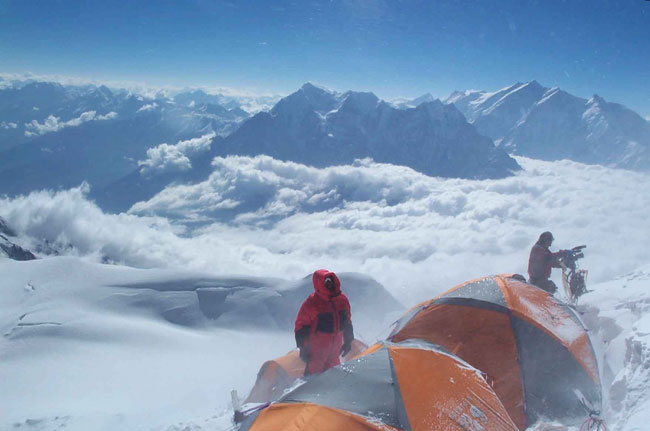
Suffocating in our own stink, we sat on that tiny perch at 21,000 feet for three days. It wasn’t snowing this time. It was the wind that was keeping us pinned down. It was a good idea to have that fence of rope up. We extended it out to the bathroom. So if you wanted to visit the little boys room you had to put your harness on and clip into the rope that led to the snowy outhouse. Hey! It’s better than squatting over a garbage bag in the vestibule of the tent.
A calm break in the constant pounding wind, I took a stroll around camp. This involved going five feet uphill to the next tent on the perch. Robert and I stood there in our down suits like two Michelin men. Maybe two Pillsbury dough boys is a better description.
Robo asked me, “you and The Greek want to go on a little rescue mission”. I knew he wasn’t talking about rescuing a climber. There was no one else on the hill except us. “ What, you drop your water bottle” I asked. “No” he continued, “we may need to stay up here a little longer and wait out this wind, we need you guys to go back down to Camp Two and get more food and fuel, cause we’re running low”.
The team was in position. All we had to do was climb to one more camp and then we would be ready to go for the summit. But how long we had to wait at Camp Three, nobody knew. All we knew was if we had to wait another day or two we needed more supplies. The Greek and I didn’t hesitate, by this time we both were working very well together. We both climbed at the same speed (although I think Mike simply was telling me he couldn’t go any faster, he could, he was just making me feel good about myself). Whatever needed to get done, we did everything we could. And now at 21,000 feet we prepared to go back down late in the day, spend the night at 19,000 feet and come back up in the morning with a fresh stock of supplies.
Calmness in the mountains sometimes appears out of nowhere like magic. One moment the weather is screaming at you to get off. And another moment it’s like someone flipped a light switch and everything is calm, sunny and peaceful. I know someone is reading th is right now going, “I know Exactly what he’s gonna say next”. And yes, you are correct.
As The Greek and I woke up at Camp Two at 19,000 feet we poked our heads out of the tent and looked up towards Camp Three. Dead Calm. I mean peaceful, beautiful calm. We both looked at each other and smiled. We knew what the boys were going to do up there. They were gonna pack up and start climbing to High Camp, which lay at 24,000 feet.
We brewed up some hot tea and began packing up our gear along with extra food and fuel to bring up. Hey, we knew someone may need it and it now could be us. As we stood outside our tent in the early glow of morning we could see the team begin climbing up to Camp Four.
This is where the climbing on the North East ridge of Dhaulagiri got to be a lot of fun. It was constantly steep with mixed ice, rock and snow. At times it became straight vertical and then it would ease up and become nearly vertical. As you approached High Camp there was a 300 foot vertical rock section. Nothing can compare to looking through your legs at empty space at 24,000 feet. The climbing was amazing. Camp Four or High Camp, well…it was amazing, with some limitation.
Confined to a much worse degree, High Camp was chipped out of hard ice. The narrow perches barely fit a tent and when you looked down from the tents, it was a long way into the abyss. If you had to get out of the tents you not only had to have your boots on, you had to have your spikes on and you had to clip into a safety rope. Falling would be simple to do without the right gear and preparation. No doubt, you had to have your wits about you at High Camp.
As The Greek and I returned to Camp Three, the rest of the team was getting close to High Camp. The team was now split up but it didn’t matter. The Greek and I were still high fiving each other as we got to camp. We were happy because looking up, the weather looked so beautiful. But looks can be deceiving. And they were.
Arriving at High Camp, tired from being on their toes all day, the team hunkered down for the night with some ramen soup and tea. The winds had picked up to a steady howl, which later turned into a steady scream. The wind never died down later that night. On a big mountain like Dhaulagiri, the plan is to wake up sometime around midnight give or take. In the darkness with aid of headlamp, you begin the slow and methodical climbing.
For those of you who have not climbed a mountain…yet…walking on flat terrain at altitude is hard work. Your body slows to a snails pace from the lack of atmospheric pressure at extreme altitudes. Leaving early in the dark of night allows climbers enough time to get up but more importantly enough time without risking getting caught in potential bad weather late in the day.
But the boys at Base Camp had to wait. The winds were too fierce to leave the fragile comfort of High Camp. Down at Camp Three, the wind wasn’t too bad but looking up a couple thousand feet we could see the wind scouring the snow slopes above. The Greek and I sat and waited eating honey out of a jar. The rest of the team was in the same predicament, minus the honey.
“Better late than never” is what Robert was thinking as he sat up all night listening to low balls. “Huh”? “What”? I know I know. Low balls in mountainese are those strong winds that you can hear far far away. At first it sounds like a distant freight train. You can hear it coming and coming. And the howl gets louder and louder and louder. Until…like a giant ball, it slams against you or hopefully moreover the tent you are in.
Robert was listening to these low balls and in the darkness of his tent he could hear the breaks in between the huge gusts were getting further and further apart. The winds were dying down. How long would they die down for? Who knew? Robert didn’t. But he did know lying at 24,000 feet with less than 2,794 more feet to climb, now was the time to make a run for it.
Meanwhile The Greek and I packed up our stuff at Camp Three and began our ascent towards High Camp. It was first light and despite not having talked to them that morning on the radios, we knew they were going for it. As you climb from Camp Three it is so steep you can’t really see anything. But we knew. The weather was gorgeous around 22,000 feet. And we imagined it was close to the same for the guys.
The Greek and I spent the next few hours grunting and grinding our way through the steep terrain. Morning turned to afternoon and we were about one hour to High Camp. When we got to the base of the 300 foot vertical rock section, we finally heard from the team. They had returned to camp.
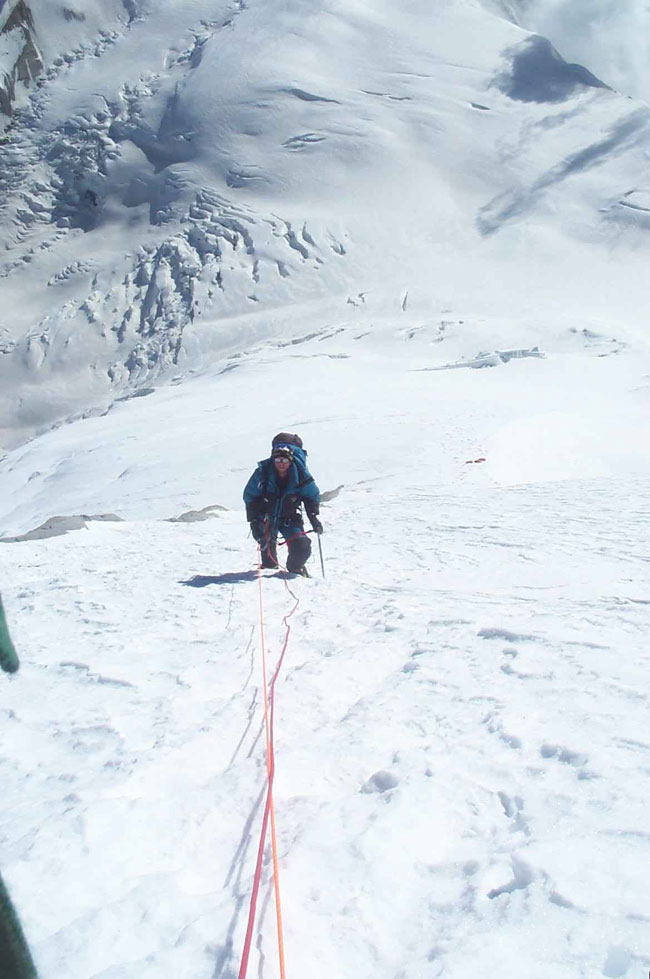
Like an omen, the wind had picked up higher on the mountain. The team was below 26,000 feet. The climbing was steep, which made it slow going for everyone. The snow conditions didn’t help either. Once on the giant glaciated face below the summit the snow had a firm two-inch crust that would break under foot leaving the climbers to push back up from the sugary snow to the solid surface. A lot of things started to add up in the negative column for the team.
As Robo stated, “it wasn’t really a difficult decision, it was the only decision”. In the heavy winds they all focused on getting down the steep terrain safely back to High Camp. When The Greek and I reached the steep camp everyone was resting and sleeping in their tents. All but Robert and the Sherps.
Unsupported and alone is fine when you’re wandering the city streets of Seattle. But to be on a mountain at 24,000 feet pretty much by yourself is another thing. And that is what Robert told The Greek and I would have to deal with if we now wanted to go for the summit. We were there, the last camp with the summit of Dhaulagiri right above us.
The entire team was planning on descending first thing in the morning. Being for us both our first Himalayan expedition, The Greek and I listened to Robert and what he thought we should do. And Robert didn’t want us to go. Sure, he wanted to give us a chance but it was his expedition. He wanted everyone to be safe. He explained the snow conditions. He told us we would be up there alone, just the two of us. If something went wrong, there was no back up, no help.
The Greek and I wanted to summit but we were there not for our own personal glory, we were there to help Robert help the team get to the summit. We simply asked Robert, “what do you think we should do”? And Robert replied, “I think you guys should come down with us”. And what Robert told us next gave both The Greek and I a little more hope.
“Andy’s already talking about going again”, Robert told us in the tent at 24,000 feet. I t was something I learned quickly to admire Andy. He gave it everything he got. Andy would exhaust every last resource in attempt to summit. As long as it was safe to do so, he was determined to get to the top of Dhaulagiri. So the plan was already in place. We all were going to go back down to Base Camp, re-group, rest and give the summit another shot. We had been denied early on in our first attempt. We were now denied in our second attempt. So why not, we were gonna go for lucky number three!
For The Greek and I, it wouldn’t have really mattered if we wanted to go for it or not. As we descended from High Camp the winds howling. It was hard enough to fight them to get down. But we did.
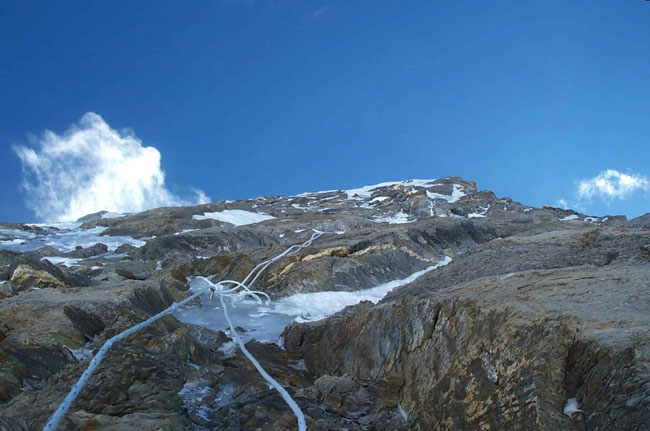
Enough was enough for a couple of the team members who were perfectly content with two valiant efforts on the summit. Andy’s two brothers along with Mike “Ole” Olson tapped out. I was in a way jealous. We had lived on that mountain for six weeks up to that point. It was sad to see them go but they needed to get back to the real world. As long as it took us to trek into Base Camp a helicopter came in and like magic they were gone. By the time the rest of us were sitting down for a nice lunch at BC, they all were probably drinking beer and eating steak sandwiches getting massages at The Hyatt in Kathmandu. Lucky Bastards.
The team was now Robert, Lucky Lindy, Andy, Tommy, The Greek and myself along with our crew of Sherpas who were also excited we were not giving up on the summit. After several days resting up in Base Camp it was time to start climbing back up and give Dhaulagiri another shot. Mid-May was quickly becoming Late-May and in Nepal that means the monsoon with its heavy rains are about to show up.
No mercy was given to us as we fought our way through the blinding snow up to Camp Three. It was living hell at this point. No longer was Dhaulagiri physically difficult. Altitude was no longer an obstacle making it easy and faster to move around.
At this point, seven weeks into the expedition the mental game was the most difficult obstacle. It seemed that every time we wanted to go higher, Dhaulagiri just kept slapping us in the face. Now on our third attempt for the summit, we couldn’t even make it to High Camp. The wind was so fierce this time I remember sitting in our tent hanging on from the inside.
Again, like a broken record, we all sat there at 21,000 feet for days. Waiting. And waiting. I can’t remember anyone talking about it. I can’t remember anyone officially making a decision. But after four days of sitting there it was like we all simultaneously got out of our tents, quietly packed up and left!
As a team we all descended back down together. The wind was still screaming. Visibility was zero. But it was like we were all in a trance. I heard no sounds. I felt nothing. Looking around once in awhile at the other team members, you could tell, with heads bowed as they down climbed, everyone had retreated to their own little world.
We were all beat up mentally and emotionally. The adversity had exhausted us. There was no time for being upset. It was what it was. Dhaulagiri was in a bad mood. All we could do in the end was leave her alone.
